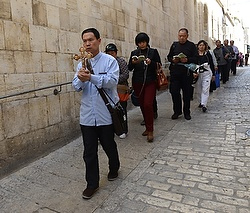by Judith Sudilovsky
 JERUSALEM (CNS) – Several pilgrim groups gathered in a sunny courtyard in Jerusalem’s Old City. They were preparing to follow a tradition reaching back at least to the fifth century: walking along the Via Dolorosa, through the cobbled streets of Jerusalem’s Old City.
JERUSALEM (CNS) – Several pilgrim groups gathered in a sunny courtyard in Jerusalem’s Old City. They were preparing to follow a tradition reaching back at least to the fifth century: walking along the Via Dolorosa, through the cobbled streets of Jerusalem’s Old City.
The Via Dolorosa represents the route taken by Jesus on the way to His crucifixion, until He was laid in the tomb. Although the route followed for this devotion has changed over the centuries, the need and desire of the Christian faithful to walk in Jesus’ footsteps has not. The current route was probably formalized in the 18th century.
“To follow the actual footsteps of Jesus is pretty amazing. It brings His message even more into our hearts,” said Marilyn McDonough, 64, a Catholic from Santa Clara, Calif. “I keep thinking about all the suffering he did for us and what he went through mentally and physically. It is overwhelming for me to be here.”
At the same time, she said, she is aware that no one knows for certain the exact places where Jesus walked. The restored 12th-century Chapel of the Flagellation that stands in the courtyard today was built on the location of a fifth-century church.
“If you take the whole area of Jerusalem, I know Jesus walked in this area. Did he step in this very spot? Maybe not, but I know he walked in other spots, and if I walk around here I can feel it in my heart,” she said.
Nigerian pilgrims sang a traditional hymn; an Asian group stood in orderly rows, chanting a prayer and led by a pilgrim carrying a large cross. Groups from Eastern Europe and the United States stood in different corners of the courtyard, some listening as a guide presented religious and historical explanations of the place, while others bent their heads in silent or communal prayer.
Starting with the first station, in the courtyard of the nearby el-’Omariyya Muslim school, they would all walk the same path, stopping to pray and reflect at the traditional 14 stations, with the final five located inside the Church of the Holy Sepulcher.
Some of the pilgrim groups walked the path carrying a cross as Jesus did. On Fridays the Franciscans lead an official procession along the Via Dolorosa.
“Sometimes you will see pilgrims here from 4 a.m. and until late at night,” said Franciscan Father Eugenio Alliata, professor of Christian archaeology at the Studium Biblicum Franciscanum.
“Everyone sings and prays according to their tradition, in their own language. Jesus walked with a real cross, the pilgrims walk with a symbolic cross. Each one has his own cross to bear, and Jesus helps them to do that.”
There is no clear consensus among biblical scholars that this current Via Dolorosa tradition is the actual route taken by Jesus. It is based on the assumption that the Pretorium, where Pontius Pilate judged Jesus, would have been at that time the Antonia Fortress, built by King Herod.
With no hard archaeological evidence of where the Pretorium was, where Jesus’ trial took place and which path He took to His own crucifixion, scholars of biblical history base their assumptions upon what they know of the layout and social mores of the Roman-occupied city of Jerusalem of that time.
Some, like archaeologist Amit Reem, believe that one probability is that the Roman governor would have stayed in the palace of the Judean king during his stays in Jerusalem, and he would have judged Jesus from there. The palace is thought to have been in what is today’s Tower of David Museum just inside Jaffa Gate.
Reem, who works for the Israel Antiquities Authority, recently finished 10 years of excavation work revealing the foundations and a drainage system of King Herod’s palace in one of the museum buildings.
“It can be fair to think that Pontius Pilate, the Roman representative of Caesar, stayed in Herod’s Palace while in Jerusalem,” said Reem, standing outside the ruins of the monumental steps leading to what is believed to have been Herod’s famous pools. The area was excavated in the 1980s by archaeologist Rene Sivan. Using an outdoor screen, the museum shows a virtual recreation of the palace pools according to first-century descriptions of the palace.
Reem noted that early Christians did not follow the current Via Dolorosa route. He said the Via Dolorosa was south of Jaffa Gate, starting from Mt. Zion, where Christians from the fifth and sixth centuries identified the Pretorium, leading from near Dung Gate to the Church of the Holy Sepulcher.
“Though we do not find any actual evidence that (Herod’s Palace) is the place where Jesus’ trial was held, it is a logical, theoretical estimation that it could’ve been here,” he said.
Father Alliata, however, is not convinced.
In his thinking, the Roman governor would have needed to stay near the place of most importance for Judaism to be on guard for any unrest during the Jewish pilgrimage holiday of Passover, when thousands of Jews, including Jesus, would ascend to the Temple Mount to give the required offerings.
